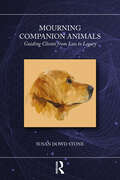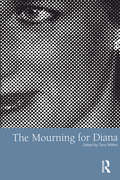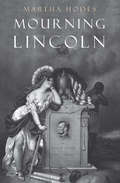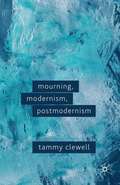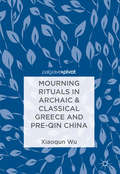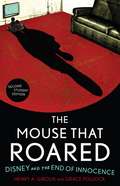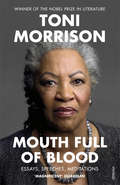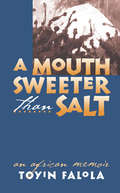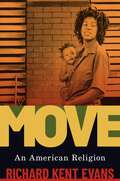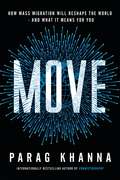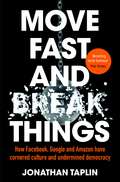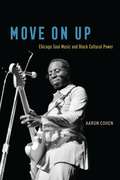- Table View
- List View
Mourning Companion Animals: Guiding Clients from Loss to Legacy
by Susan Dowd StoneMourning Companion Animals is a guidebook for mental health clinicians searching for effective, compassionate resources to guide their clients through the often-devastating experience of animal companion loss.Chapters offer powerful and comprehensive strategies to heal animal companion loss based in sound, evidenced based, theoretical perspectives. The included author-generated inventory, the animal companion bereavement questionnaire, provides further assistance in clinician exploration of each client’s unique bond with their lost companion.The book’s content is the result of more than twenty-five of extensive work within the human-animal bond, clinical training in the referenced therapies, and application of major psychodynamic theories.
Mourning Diana: Nation, Culture and the Performance of Grief
by Adrian Kear Deborah Lynn SteinbergThe death of Diana, Princess of Wales, on September 1 1997, prompted public demonstrations of grief on an almost unprecented global scale. But, while global media coverage of the events following her death appeared to create an international 'community of mourning', popular reacions in fact reflected the complexities of the princess's public image and the tensions surrounding the popular conception of royalty. Mourning Diana examines the events which followed the death of Diana as a series of cultural-political phenomena, from the immediate aftermath as crowds gathered in public spaces and royal palaces, to the state funeral in Westminister Abbey, examining the performance of grief and the involvement of the global media in the creation of narratives and spectacles relating to the commemoration of her life. Contributors investigate the complex iconic status of Diana, as a public figure able to sustain a host of alternative identifications, and trace the posthumous romanticisation of aspects of her life such as her charity activism and her relationship with Dodi al Fayed. The contributors argue that the events following the death of Diana dramatised a complex set of cultural tensions in which the boundaries dividing nationhood and citizenship, charity and activism, private feeling and public politics, were redrawn.
Mourning Diana: Nation, Culture and the Performance of Grief
by Adrian Kear Deborah Lynn SteinbergThe death of Diana, Princess of Wales, on September 1 1997, prompted public demonstrations of grief on an almost unprecented global scale. But, while global media coverage of the events following her death appeared to create an international 'community of mourning', popular reacions in fact reflected the complexities of the princess's public image and the tensions surrounding the popular conception of royalty. Mourning Diana examines the events which followed the death of Diana as a series of cultural-political phenomena, from the immediate aftermath as crowds gathered in public spaces and royal palaces, to the state funeral in Westminister Abbey, examining the performance of grief and the involvement of the global media in the creation of narratives and spectacles relating to the commemoration of her life. Contributors investigate the complex iconic status of Diana, as a public figure able to sustain a host of alternative identifications, and trace the posthumous romanticisation of aspects of her life such as her charity activism and her relationship with Dodi al Fayed. The contributors argue that the events following the death of Diana dramatised a complex set of cultural tensions in which the boundaries dividing nationhood and citizenship, charity and activism, private feeling and public politics, were redrawn.
The Mourning for Diana
by Tony WalterThe unexpected death of Diana, Princess of Wales, in Paris on August 31st 1997 led to a period of mourning over the next week that took the world by surprise. Major institutions - the media, the royal family, the church, the police - for once had no pre-planned script. For the public, this was a story with an ending they had not anticipated. How did these institutions and the public create a cultural order in the face of such disorder? Both those involved in the mourning and those who objected to it struggled to understand the depth and breadth of emotion shaking Britain and the world. Mourning was focused on London, where Diana's body lay, and on Diana's home, Kensington Palace. Throughout the city and especially in Kensington Gardens, millions left shrines to the dead princess made of flowers, messages, teddy bears and other objects. In towns and villages around the UK, this was repeated. The mourning was also global, with media dominated by Diana's death in scores of countries. The funeral itself had a record-breaking world television audience, and messages of condolence floated around the globe in cyber-space. How unique was all this? Does it mark a shift in the culture of mourning, of the position of the monarchy, of the role of emotion in British culture? How does it compare with the mourning for other super-icons - JFK, Evita, Elvis, and Monroe? Was it media-induced hysteria? Or was it simply a magnification of normal mourning behaviour? Focusing on the extraordinary actions of millions of ordinary people, this book documents what happened and shows how a modern rational society coped with the unexpected in a proto-revolutionary week that left participants and objectors alike asking 'why did we behave like this?'
The Mourning for Diana
by Tony WalterThe unexpected death of Diana, Princess of Wales, in Paris on August 31st 1997 led to a period of mourning over the next week that took the world by surprise. Major institutions - the media, the royal family, the church, the police - for once had no pre-planned script. For the public, this was a story with an ending they had not anticipated. How did these institutions and the public create a cultural order in the face of such disorder? Both those involved in the mourning and those who objected to it struggled to understand the depth and breadth of emotion shaking Britain and the world. Mourning was focused on London, where Diana's body lay, and on Diana's home, Kensington Palace. Throughout the city and especially in Kensington Gardens, millions left shrines to the dead princess made of flowers, messages, teddy bears and other objects. In towns and villages around the UK, this was repeated. The mourning was also global, with media dominated by Diana's death in scores of countries. The funeral itself had a record-breaking world television audience, and messages of condolence floated around the globe in cyber-space. How unique was all this? Does it mark a shift in the culture of mourning, of the position of the monarchy, of the role of emotion in British culture? How does it compare with the mourning for other super-icons - JFK, Evita, Elvis, and Monroe? Was it media-induced hysteria? Or was it simply a magnification of normal mourning behaviour? Focusing on the extraordinary actions of millions of ordinary people, this book documents what happened and shows how a modern rational society coped with the unexpected in a proto-revolutionary week that left participants and objectors alike asking 'why did we behave like this?'
Mourning Lincoln
by Martha HodesThe news of Abraham Lincoln’s assassination on April 15, 1865, just days after Confederate surrender, astounded the war-weary nation. Massive crowds turned out for services and ceremonies. Countless expressions of grief and dismay were printed in newspapers and preached in sermons. Public responses to the assassination have been well chronicled, but this book is the first to delve into the personal and intimate responses of everyday people—northerners and southerners, soldiers and civilians, black people and white, men and women, rich and poor. Through deep and thoughtful exploration of diaries, letters, and other personal writings penned during the spring and summer of 1865, Martha Hodes, one of our finest historians, captures the full range of reactions to the president’s death—far more diverse than public expressions would suggest. She tells a story of shock, glee, sorrow, anger, blame, and fear. “’Tis the saddest day in our history,” wrote a mournful man. It was “an electric shock to my soul,” wrote a woman who had escaped from slavery. “Glorious News!” a Lincoln enemy exulted. “Old Lincoln is dead, and I will kill the goddamned Negroes now,” an angry white southerner ranted. For the black soldiers of the Fifty-Fourth Massachusetts, it was all “too overwhelming, too lamentable, too distressing” to absorb. There are many surprises in the story Hodes tells, not least the way in which even those utterly devastated by Lincoln’s demise easily interrupted their mourning rituals to attend to the most mundane aspects of everyday life. There is also the unexpected and unabated virulence of Lincoln’s northern critics, and the way Confederates simultaneously celebrated Lincoln’s death and instantly—on the very day he died—cast him as a fallen friend to the defeated white South. Hodes brings to life a key moment of national uncertainty and confusion, when competing visions of America’s future proved irreconcilable and hopes for racial justice in the aftermath of the Civil War slipped from the nation’s grasp. Hodes masterfully brings the tragedy of Lincoln’s assassination alive in human terms—terms that continue to stagger and rivet us one hundred and fifty years after the event they so strikingly describe.
Mourning, Modernism, Postmodernism
by T. ClewellMourning, Modernism, Postmodernism traces the emergence of a fundamentally new way of writing about individual and collective mourning, demonstrating how a refusal of consolation and closure succeeds in promoting a progressive cultural politics crucial for reimaging gender, racial, and sexual subjects.
Mourning Remains: State Atrocity, Exhumations, and Governing the Disappeared in Peru's Postwar Andes
by Isaias Rojas-PerezMourning Remains examines the attempts to find, recover, and identify the bodies of Peruvians who were disappeared during the 1980s and 1990s counterinsurgency campaign in Peru's central southern Andes. Isaias Rojas-Perez explores the lives and political engagement of elderly Quechua mothers as they attempt to mourn and seek recognition for their kin. Of the estimated 16,000 Peruvians disappeared during the conflict, only the bodies of 3,202 victims have been located, and only 1,833 identified. The rest remain unknown or unfound, scattered across the country and often shattered beyond recognition. Rojas-Perez examines how, in the face of the state's failure to account for their missing dead, the mothers rearrange senses of community, belonging, authority, and the human to bring the disappeared back into being through everyday practices of mourning and memorialization. Mourning Remains reveals how collective mourning becomes a political escape from the state's project of governing past death and how the dead can help secure the future of the body politic.
Mourning Rituals in Archaic & Classical Greece and Pre-Qin China
by Xiaoqun WuThis pivot compares mourning rituals in Archaic & Classical Greece and Pre-Qin China to illustrate some of the principles and methods used in comparative studies. It focuses on three main aspects of mourning of the dead before burial — lamentation, mourners’ gestures and behaviors, and mourning apparel — to demonstrate the cultural function, purpose, and social influence of mourning. A key comparative study of rituals at the heart of both Western and Chinese culture, this text highlights the cultural function and social influence of rituals of two ancient peoples and will be of interest to all scholars of comparative religion, sociology and anthropology.
Mourning Rituals in Archaic & Classical Greece and Pre-Qin China
by Xiaoqun WuThis pivot compares mourning rituals in Archaic & Classical Greece and Pre-Qin China to illustrate some of the principles and methods used in comparative studies. It focuses on three main aspects of mourning of the dead before burial — lamentation, mourners’ gestures and behaviors, and mourning apparel — to demonstrate the cultural function, purpose, and social influence of mourning. A key comparative study of rituals at the heart of both Western and Chinese culture, this text highlights the cultural function and social influence of rituals of two ancient peoples and will be of interest to all scholars of comparative religion, sociology and anthropology.
Mourning the Dreams: How Parents Create Meaning from Miscarriage, Stillbirth, and Early Infant Death (International Institute for Qualitative Methodology Series)
by Claudia MalacridaMourning the Dreams is an accessible and moving account of parents’ experiences of grief and recovery after losing an infant during pregnancy, childbirth, or within the first month of life. Drawing from the sociology of emotions, health research and psychology, her own experience, and a range of qualitative methods, Claudia Malacrida finds that bereaved parents not only grieve their child and its unrealized potential, but often find their personal experiences are at odds with social forces and prevailing assumptions about the nature of their loss and how they should react to is. She explores the meanings parents create as they face denial, silence, and other reactions from friends, family, communities, coworkers, the medical community, and even within spousal relationships. She also describes the courage and creativity of parents who create and negotiate meanings that help them grieve, recover, and manage relationships.
Mourning the Dreams: How Parents Create Meaning from Miscarriage, Stillbirth, and Early Infant Death (International Institute for Qualitative Methodology Series)
by Claudia MalacridaMourning the Dreams is an accessible and moving account of parents’ experiences of grief and recovery after losing an infant during pregnancy, childbirth, or within the first month of life. Drawing from the sociology of emotions, health research and psychology, her own experience, and a range of qualitative methods, Claudia Malacrida finds that bereaved parents not only grieve their child and its unrealized potential, but often find their personal experiences are at odds with social forces and prevailing assumptions about the nature of their loss and how they should react to is. She explores the meanings parents create as they face denial, silence, and other reactions from friends, family, communities, coworkers, the medical community, and even within spousal relationships. She also describes the courage and creativity of parents who create and negotiate meanings that help them grieve, recover, and manage relationships.
The Mouse That Roared: Disney And The End Of Innocence ( PDF)
by Henry A. Giroux Grace PollockThis expanded and revised edition explores and updates the cultural politics of the Walt Disney Company and how its ever-expanding list of products, services, and media function as teaching machines that shape children's culture into a largely commercial endeavor. The Disney conglomerate remains an important case study for understanding both the widening influence of free-market fundamentalism in the new millennium and the ways in which messages of powerful corporations have been appropriated and increasingly resisted in global contexts. New in this edition is a discussion of Disney's shift in its marketing strategies towards targeting tweens and teens, as Disney promises to provide (via participation in consumer culture) the tools through which young people construct and support their identities, values, and knowledge of the world. The updated chapters from the highly acclaimed first edition are complimented with two new chapters, 'Globalizing the Disney Empire' and 'Disney, Militarization, and the National Security State After 9/11,' which extend the analysis of Disney's effects on young people to a consideration of the political and economic dimensions of Disney as a U.S.-based megacorporation, linking the importance of critical reception on an individual scale to a broader conception of democratic global community.
Mousterian Lithic Technology: An Ecological Perspective
by Steven L. KuhnHuman beings depend more on technology than any other animal--the use of tools and weapons is vital to the survival of our species. What processes of biocultural evolution led to this unique dependence? Steven Kuhn turns to the Middle Paleolithic (Mousterian) and to artifacts associated with Neanderthals, the most recent human predecessors. His study examines the ecological, economic, and strategic factors that shaped the behavior of Mousterian tool makers, revealing how these hominids brought technological knowledge to bear on the basic problems of survival.Kuhn's main database consists of assemblages of stone artifacts from four caves and a series of open-air localities situated on the western coast of the Italian peninsula. Variations in the ways stone tools were produced, maintained, and discarded demonstrate how Mousterian hominids coped with the problems of keeping mobile groups supplied with the artifacts and raw materials they used on a daily basis. Changes through time in lithic technology were closely tied to shifting strategies for hunting and collecting food. Some of the most provocative findings of this study stem from observations about the behavioral flexibility of Mousterian populations and the role of planning in foraging and technology.Originally published in 1995.The Princeton Legacy Library uses the latest print-on-demand technology to again make available previously out-of-print books from the distinguished backlist of Princeton University Press. These editions preserve the original texts of these important books while presenting them in durable paperback and hardcover editions. The goal of the Princeton Legacy Library is to vastly increase access to the rich scholarly heritage found in the thousands of books published by Princeton University Press since its founding in 1905.
Mouth Full of Blood: Essays, Speeches, Meditations
by Toni MorrisonA vital new non-fiction collection from one of the most celebrated and revered writers of our time‘Word-work is sublime, she thinks, because it is generative; it makes meaning that secures our difference, our human difference—the way in which we are like no other life. We die. That may be the meaning of life. But we do language. That may be the measure of our lives.’The Nobel Lecture in Literature, 1993Spanning four decades, these essays, speeches and meditations interrogate the world around us. They are concerned with race, gender and globalisation. The sweep of American history and the current state of politics. The duty of the press and the role of the artist. Throughout A Mouth Full of Blood our search for truth, moral integrity and expertise is met by Toni Morrison with controlled anger, elegance and literary excellence.The collection is structured in three parts and these are heart-stoppingly introduced by a prayer for the dead of 9/11, a meditation on Martin Luther King and a eulogy for James Baldwin. Morrison’s Nobel lecture, on the power of language, is accompanied by lectures to Amnesty International and the Newspaper Association of America. She speaks to graduating students and visitors to both the Louvre and America’s Black Holocaust Museum. She revisits The Bluest Eye, Sula and Beloved; reassessing the novels that have become touchstones for generations of readers.A Mouth Full of Blood is a powerful, erudite and essential gathering of ideas that speaks to us all.‘To what do we pay greatest allegiance? Family, language group, culture, country, gender? Religion, race? And, if none of these matter, are we urbane, cosmopolitan or simply lonely? In other words, how do we decide where we belong? What convinces us that we do?’ The Alexander Lecture series, 2002
A Mouth Sweeter Than Salt: An African Memoir
by Toyin Falola"Toyin Falola has given us what is truly rare in modern African writing: a seriously funny, racy, irreverent package of memories, and full of the most wonderful pieces of poetry and ordinary information. It is a matter of some interest, that the only other volume A Mouth Sweeter Than Salt reminds one of is Ake, by Wole Soyinka. What is it about these Yorubas?" -Ama Ata Aidoo "A splendid coming-of-age story so full of vivid color and emotion, the words seem to dance off the page. But this is not only Falola's memoir; it is an account of a new nation coming into being and the tensions and negotiations that invariably occur between city and country, tradition and modernity, men and women, rich and poor. A truly beautiful book." -Robin D. G. Kelley "More than a personal memoir, this book is a rich minihistory of contemporary Nigeria recorded in delicious detail by a perceptive eyewitness who grew up at the crossroads of many cultures." -Bernth Lindfors "The reader is irresistibly drawn into Falola's world. The prose is lucid. There is humor. This work is sweet. Period." -Ngugi wa Thiongo'o A Mouth Sweeter Than Salt gathers the stories and reflections of the early years of Toyin Falola, the grand historian of Africa and one of the greatest sons of Ibadan, the notable Yoruba city-state in Nigeria. Redefining the autobiographical genre altogether, Falola miraculously weaves together personal, historical, and communal stories, along with political and cultural developments in the period immediately preceding and following Nigeria's independence, to give us a unique and enduring picture of the Yoruba in the mid-twentieth century. This is truly a literary memoir, told in language rich with proverbs, poetry, song, and humor. Falola's memoir is far more than the story of one man's childhood experiences; rather, he presents us with the riches of an entire culture and community-its history, traditions, pleasures, mysteries, household arrangements, forms of power, struggles, and transformations.
MOVE: An American Religion
by Richard Kent EvansWhat is a religion? That is the question that Richard Kent Evans attempts to answer in this book. He does so through the story of MOVE, a little-known group with a fascinating story. MOVE emerged in Philadelphia in the early 1970s. It was a small, mostly African American group devoted to the teachings of John Africa. In 1985, the Philadelphia Police Department -- working in concert with federal and state law enforcement -- attacked a home that "MOVE people" as they preferred to be known, shared in West Philadelphia. Hundreds of police officers and firefighters laid siege to the building using tear gas, ten thousand rounds of ammunition, and improvised explosives. Most infamously, a police officer riding in a helicopter dropped a bomb containing C-4 explosives, which he had acquired from the FBI, onto the roof of the MOVE house. The bomb started a fire, which officials allowed to spread in hopes of chasing the MOVE people out of the house. Police officers fired upon those who tried to escape the flames. Eleven MOVE people died in the attack, including John Africa. Five of those who died were children. In this book, Richard Kent Evans tells the story of MOVE -- a story that has been virtually lost outside of Philadelphia. What was MOVE? Many MOVE members thought of themselves as belonging to a religion, and they sought legal recognition. But to others, including other religious groups like the Quakers and, more importantly, the courts, MOVE was anything but a religion. Evans dives deep into how we decide what constitutes a genuine religious tradition, and the enormous consequences of that decision.
MOVE: An American Religion
by Richard Kent EvansWhat is a religion? That is the question that Richard Kent Evans attempts to answer in this book. He does so through the story of MOVE, a little-known group with a fascinating story. MOVE emerged in Philadelphia in the early 1970s. It was a small, mostly African American group devoted to the teachings of John Africa. In 1985, the Philadelphia Police Department -- working in concert with federal and state law enforcement -- attacked a home that "MOVE people" as they preferred to be known, shared in West Philadelphia. Hundreds of police officers and firefighters laid siege to the building using tear gas, ten thousand rounds of ammunition, and improvised explosives. Most infamously, a police officer riding in a helicopter dropped a bomb containing C-4 explosives, which he had acquired from the FBI, onto the roof of the MOVE house. The bomb started a fire, which officials allowed to spread in hopes of chasing the MOVE people out of the house. Police officers fired upon those who tried to escape the flames. Eleven MOVE people died in the attack, including John Africa. Five of those who died were children. In this book, Richard Kent Evans tells the story of MOVE -- a story that has been virtually lost outside of Philadelphia. What was MOVE? Many MOVE members thought of themselves as belonging to a religion, and they sought legal recognition. But to others, including other religious groups like the Quakers and, more importantly, the courts, MOVE was anything but a religion. Evans dives deep into how we decide what constitutes a genuine religious tradition, and the enormous consequences of that decision.
Move: How Mass Migration Will Reshape the World – and What It Means for You
by Parag KhannaWhere will you live in 2030? Where will your children settle in 2040? What will the map of humanity look like in 2050?In the 60,000 years since people began colonising the continents, a recurring feature of human civilisation has been mobility - the constant search for resources and stability. Seismic global events - wars and genocides, revolutions and pandemics - have only accelerated the process. The map of humanity isn't settled, not now, not ever.As climate change tips toward full-blown crisis, economies collapse, governments destabilise and technology disrupts, we're entering a new age of mass migrations - one that will scatter both the dispossessed and the well-off. Which areas will people abandon and where will they resettle? Which countries will accept or reject them? As today's world population, which includes four billion restless youth, votes with their feet, what map of human geography will emerge?Here global strategy advisor Parag Khanna provides an illuminating and authoritative vision of the next phase of human civilisation - one that is both mobile and sustainable. As the book explores, in the years ahead people will move to where the resources are and technologies will flow to the people who need them, returning us to our nomadic roots while building more secure habitats. Move is a fascinating look at the deep trends that are shaping the most likely scenarios for the future. Most importantly, it guides each of us as we determine our optimal location on humanity's ever-changing map.
Move and Meet: Eine Studie zu Teilhabeprojekten im Sport aus der Perspektive der Angewandten Ethnologie (Ethnologie als Praxis | Anthropology as Practice)
by Laura Verweyen„Move and Meet“ – der Titel dieser Arbeit ist zugleich der Name eines Sport- und Bildungsvereins, der sich im Rahmen der Forschungen zur vorliegenden Studie im Jahr 2021 gründete. Der Verein ist damit das Produkt eines Teilhabe-Experiments, das 2017 in einem ersten Sportkurs für Frauen mit Fluchterfahrung seinen Anfang nahm. Dieser wurde als anwendungsorientierter Teil der vorliegenden Studie im Bereich der Angewandten Ethnologie konzipiert und entwickelte sich zu einem Begegnungs- und Empowerment-Raum, der auf den Motiven und Bedarfen der Sportlerinnen, der haupt- und ehrenamtlichen Trainerinnen und weiterer Engagierter beruhte. Diese Studie zeigt auf, welchen Beitrag der Sport für die soziale und gesellschaftliche Teilhabe von Menschen mit Migrations- und Fluchterfahrung und insbesondere für Frauen mit Fluchterfahrung leisten kann. Repräsentation und Partizipation, Ressourcen, Sportmotive und -bedarfe sowie die Kommunikation und Interaktion von Sportler:innen und Engagierten werden in den Blick genommen. Die Bedeutung einer diversitätssensiblen Vereinsentwicklung für den Sportverein als Sport-, Begegnungs- und Bildungsakteur wird herausgearbeitet.
Move Fast and Break Things: How Facebook, Google, and Amazon Have Cornered Culture and What It Means For All Of Us (Expert Thinking Ser.)
by Jonathan TaplinA Financial Times 'Best Thing I Read This Year' LONGLISTED FOR THE FT & MCKINSEY BUSINESS BOOK OF THE YEAR AWARDGoogle. Amazon. Facebook. The modern world is defined by vast digital monopolies turning ever-larger profits. Those of us who consume the content that feeds them are farmed for the purposes of being sold ever more products and advertising. Those that create the content – the artists, writers and musicians – are finding they can no longer survive in this unforgiving economic landscape. But it didn’t have to be this way. In Move Fast and Break Things, Jonathan Taplin offers a succinct and powerful history of how online life began to be shaped around the values of the entrepreneurs like Peter Thiel and Larry Page who founded these all-powerful companies. Their unprecedented growth came at the heavy cost of tolerating piracy of books, music and film, while at the same time promoting opaque business practices and subordinating the privacy of individual users to create the surveillance marketing monoculture in which we now live.It is the story of a massive reallocation of revenue in which $50 billion a year has moved from the creators and owners of content to the monopoly platforms. With this reallocation of money comes a shift in power. Google, Facebook and Amazon now enjoy political power on par with Big Oil and Big Pharma, which in part explains how such a tremendous shift in revenues from creators to platforms could have been achieved and why it has gone unchallenged for so long.And if you think that’s got nothing to do with you, their next move is to come after your jobs. Move Fast and Break Things is a call to arms, to say that is enough is enough and to demand that we do everything in our power to create a different future.
Move On Up: Chicago Soul Music and Black Cultural Power
by Aaron CohenA Chicago Tribune Book of 2019, Notable Chicago Reads A Booklist Top 10 Arts Book of 2019 A No Depression Top Music Book of 2019 Curtis Mayfield. The Chi-Lites. Chaka Khan. Chicago’s place in the history of soul music is rock solid. But for Chicagoans, soul music in its heyday from the 1960s to the 1980s was more than just a series of hits: it was a marker and a source of black empowerment. In Move On Up, Aaron Cohen tells the remarkable story of the explosion of soul music in Chicago. Together, soul music and black-owned businesses thrived. Record producers and song-writers broadcast optimism for black America’s future through their sophisticated, jazz-inspired productions for the Dells and many others. Curtis Mayfield boldly sang of uplift with unmistakable grooves like “We’re a Winner” and “I Plan to Stay a Believer.” Musicians like Phil Cohran and the Pharaohs used their music to voice Afrocentric philosophies that challenged racism and segregation, while Maurice White of Earth, Wind, and Fire and Chaka Khan created music that inspired black consciousness. Soul music also accompanied the rise of African American advertisers and the campaign of Chicago’s first black mayor, Harold Washington, in 1983. This empowerment was set in stark relief by the social unrest roiling in Chicago and across the nation: as Chicago’s homegrown record labels produced rising stars singing songs of progress and freedom, Chicago’s black middle class faced limited economic opportunities and deep-seated segregation, all against a backdrop of nationwide deindustrialization. Drawing on more than one hundred interviews and a music critic’s passion for the unmistakable Chicago soul sound, Cohen shows us how soul music became the voice of inspiration and change for a city in turmoil.
Move On Up: Chicago Soul Music and Black Cultural Power
by Aaron CohenA Chicago Tribune Book of 2019, Notable Chicago Reads A Booklist Top 10 Arts Book of 2019 A No Depression Top Music Book of 2019 Curtis Mayfield. The Chi-Lites. Chaka Khan. Chicago’s place in the history of soul music is rock solid. But for Chicagoans, soul music in its heyday from the 1960s to the 1980s was more than just a series of hits: it was a marker and a source of black empowerment. In Move On Up, Aaron Cohen tells the remarkable story of the explosion of soul music in Chicago. Together, soul music and black-owned businesses thrived. Record producers and song-writers broadcast optimism for black America’s future through their sophisticated, jazz-inspired productions for the Dells and many others. Curtis Mayfield boldly sang of uplift with unmistakable grooves like “We’re a Winner” and “I Plan to Stay a Believer.” Musicians like Phil Cohran and the Pharaohs used their music to voice Afrocentric philosophies that challenged racism and segregation, while Maurice White of Earth, Wind, and Fire and Chaka Khan created music that inspired black consciousness. Soul music also accompanied the rise of African American advertisers and the campaign of Chicago’s first black mayor, Harold Washington, in 1983. This empowerment was set in stark relief by the social unrest roiling in Chicago and across the nation: as Chicago’s homegrown record labels produced rising stars singing songs of progress and freedom, Chicago’s black middle class faced limited economic opportunities and deep-seated segregation, all against a backdrop of nationwide deindustrialization. Drawing on more than one hundred interviews and a music critic’s passion for the unmistakable Chicago soul sound, Cohen shows us how soul music became the voice of inspiration and change for a city in turmoil.
Move On Up: Chicago Soul Music and Black Cultural Power
by Aaron CohenA Chicago Tribune Book of 2019, Notable Chicago Reads A Booklist Top 10 Arts Book of 2019 A No Depression Top Music Book of 2019 Curtis Mayfield. The Chi-Lites. Chaka Khan. Chicago’s place in the history of soul music is rock solid. But for Chicagoans, soul music in its heyday from the 1960s to the 1980s was more than just a series of hits: it was a marker and a source of black empowerment. In Move On Up, Aaron Cohen tells the remarkable story of the explosion of soul music in Chicago. Together, soul music and black-owned businesses thrived. Record producers and song-writers broadcast optimism for black America’s future through their sophisticated, jazz-inspired productions for the Dells and many others. Curtis Mayfield boldly sang of uplift with unmistakable grooves like “We’re a Winner” and “I Plan to Stay a Believer.” Musicians like Phil Cohran and the Pharaohs used their music to voice Afrocentric philosophies that challenged racism and segregation, while Maurice White of Earth, Wind, and Fire and Chaka Khan created music that inspired black consciousness. Soul music also accompanied the rise of African American advertisers and the campaign of Chicago’s first black mayor, Harold Washington, in 1983. This empowerment was set in stark relief by the social unrest roiling in Chicago and across the nation: as Chicago’s homegrown record labels produced rising stars singing songs of progress and freedom, Chicago’s black middle class faced limited economic opportunities and deep-seated segregation, all against a backdrop of nationwide deindustrialization. Drawing on more than one hundred interviews and a music critic’s passion for the unmistakable Chicago soul sound, Cohen shows us how soul music became the voice of inspiration and change for a city in turmoil.
Move On Up: Chicago Soul Music and Black Cultural Power
by Aaron CohenA Chicago Tribune Book of 2019, Notable Chicago Reads A Booklist Top 10 Arts Book of 2019 A No Depression Top Music Book of 2019 Curtis Mayfield. The Chi-Lites. Chaka Khan. Chicago’s place in the history of soul music is rock solid. But for Chicagoans, soul music in its heyday from the 1960s to the 1980s was more than just a series of hits: it was a marker and a source of black empowerment. In Move On Up, Aaron Cohen tells the remarkable story of the explosion of soul music in Chicago. Together, soul music and black-owned businesses thrived. Record producers and song-writers broadcast optimism for black America’s future through their sophisticated, jazz-inspired productions for the Dells and many others. Curtis Mayfield boldly sang of uplift with unmistakable grooves like “We’re a Winner” and “I Plan to Stay a Believer.” Musicians like Phil Cohran and the Pharaohs used their music to voice Afrocentric philosophies that challenged racism and segregation, while Maurice White of Earth, Wind, and Fire and Chaka Khan created music that inspired black consciousness. Soul music also accompanied the rise of African American advertisers and the campaign of Chicago’s first black mayor, Harold Washington, in 1983. This empowerment was set in stark relief by the social unrest roiling in Chicago and across the nation: as Chicago’s homegrown record labels produced rising stars singing songs of progress and freedom, Chicago’s black middle class faced limited economic opportunities and deep-seated segregation, all against a backdrop of nationwide deindustrialization. Drawing on more than one hundred interviews and a music critic’s passion for the unmistakable Chicago soul sound, Cohen shows us how soul music became the voice of inspiration and change for a city in turmoil.
